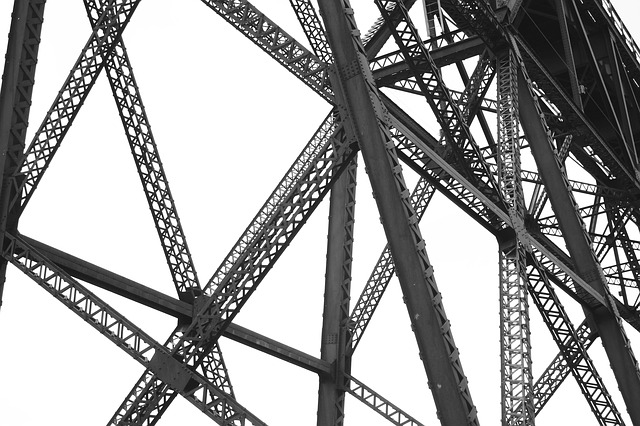Steel frame
Structural steelwork can be used to form the 'skeleton' frame of a building or other built asset, typically consisting of vertical columns and horizontal beams which are riveted, bolted or welded together in a rectilinear grid.
- Steel beams are horizontal structural members that resist loads applied laterally to their axis. For more information, see Types of beam.
- Steel columns are vertical structural members that transfer compressive loads. For more information, see Types of column.
This grid of beams and columns can then be used to support the building’s floors, roof, walls, cladding, and so on.
Steel frame construction is commonly used in high-rise, industrial, warehouse, residential buildings and so on. Its advantages include:
- High strength.
- Relatively low weight.
- Ability to span large distances.
- Ease of installation.
- Off site fabrication, allowing high quality.
- Mass production of repeating units.
- Availability of a wide range of ready-made structural sections.
- Ability to resist dynamic forces such as wind and earthquakes.
- Adaptability to any kind of shape.
- Ability to be clad with a wide variety of materials.
- Suitability to a wide range of joining methods.
Types of steel frame construction include:
- Conventional steel fabrication: Steel components are fabricated off-site, cut to the correct lengths and welded together.
- Bolted steel: Steel components are fabricated off-site and bolted in place on site.
- Light gauge steel: Similar to timber frame construction, with light gauge steel members instead of timber studs.
Hot-rolled steel is commonly used to form steel beams and columns. They are created by passing heated steel between large rollers, which deform it into the required shape, such as H, I, W, S and C shapes, angles, tubes, and so on.
As steel softens at high temperatures, which can cause structural collapse, frames require some form of fire protection. They may be encased in masonry, concrete or plasterboard, or sprayed with an insulating coating. Steel is also prone to corrosion in humid climates or marine environments.
The addition of bracing to a steel frame increases its stability against lateral loads such as wind loading and seismic pressure. The members in a braced frame are generally also made of structural steel, which can work effectively both in tension and compression. For more information, see Braced frame.
Portal frames are a type of structural frame, that, in their simplest form, are characterised by a beam (or rafter) supported at either end by columns, however, the joints between the beam and columns are 'rigid' so that the bending moment in the beam is transferred to the columns. This means that the beam can be reduced in sectional size and can span large distances. For more information, see Portal frame.
[edit] Related articles on Designing Buildings
- 8 reasons why structural steel frames are advantageous for any building project.
- Braced frame.
- Concept structural design of buildings.
- Concrete frame.
- Concrete-steel composite structures.
- Girder.
- Guidance for construction quality management professionals: Structural Steelwork.
- Gusset.
- Light steel frame.
- Light gauge steel framing systems.
- Portal frame.
- Off-site prefabrication of buildings: A guide to connection choices.
- Skeleton frame.
- Steel structural framing systems.
- Structural steelwork.
- Timber frame.
- Types of frame.
- Types of steel.
Featured articles and news
RTPI leader to become new CIOB Chief Executive Officer
Dr Victoria Hills MRTPI, FICE to take over after Caroline Gumble’s departure.
Social and affordable housing, a long term plan for delivery
The “Delivering a Decade of Renewal for Social and Affordable Housing” strategy sets out future path.
A change to adoptive architecture
Effects of global weather warming on architectural detailing, material choice and human interaction.
The proposed publicly owned and backed subsidiary of Homes England, to facilitate new homes.
How big is the problem and what can we do to mitigate the effects?
Overheating guidance and tools for building designers
A number of cool guides to help with the heat.
The UK's Modern Industrial Strategy: A 10 year plan
Previous consultation criticism, current key elements and general support with some persisting reservations.
Building Safety Regulator reforms
New roles, new staff and a new fast track service pave the way for a single construction regulator.
Architectural Technologist CPDs and Communications
CIAT CPD… and how you can do it!
Cooling centres and cool spaces
Managing extreme heat in cities by directing the public to places for heat stress relief and water sources.
Winter gardens: A brief history and warm variations
Extending the season with glass in different forms and terms.
Restoring Great Yarmouth's Winter Gardens
Transforming one of the least sustainable constructions imaginable.
Construction Skills Mission Board launch sector drive
Newly formed government and industry collaboration set strategy for recruiting an additional 100,000 construction workers a year.
New Architects Code comes into effect in September 2025
ARB Architects Code of Conduct and Practice available with ongoing consultation regarding guidance.
Welsh Skills Body (Medr) launches ambitious plan
The new skills body brings together funding and regulation of tertiary education and research for the devolved nation.
Paul Gandy FCIOB announced as next CIOB President
Former Tilbury Douglas CEO takes helm.
UK Infrastructure: A 10 Year Strategy. In brief with reactions
With the National Infrastructure and Service Transformation Authority (NISTA).























